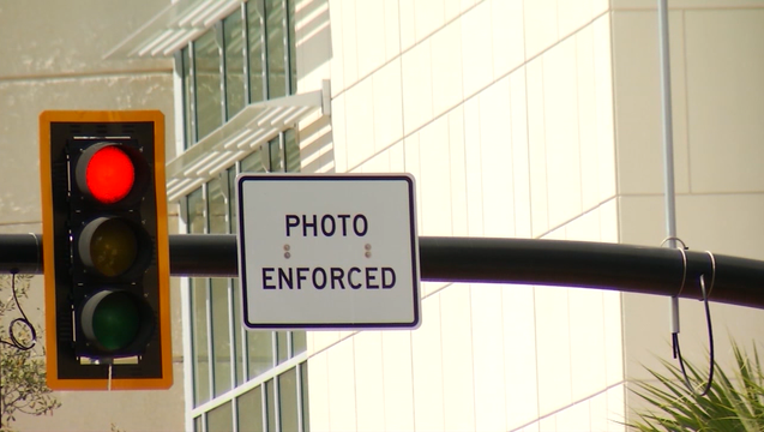Chicago triples 'grace period' for red-light cameras

CHICAGO (SUN TIMES MEDIA WIRE) - Chicago motorists caught on camera blowing through red lights will have triple the “grace period” before being slapped with $100 tickets, under a change made Monday that could reduce the number of tickets issued by nearly a third.
Last year, the city issued 586,415 red-light tickets — and about 29 percent of those went to motorists who entered the intersection between one-tenths and three-tenths of a second after the light had turned red, the Chicago Sun-Times is reporting.
By tripling the “grace period” to three-tenths of a second — as suggested by the Northwestern University Traffic Center — the city is likely to issue 29 percent fewer tickets, according to city Transportation Commissioner Rebekah Scheinfeld.
That could cost the city $17 million in annual revenue from red-light camera tickets.
At Northwestern’s suggestion, Scheinfeld said the city has also agreed to begin the process to move red-light cameras from six existing intersections and place them at five new locations where the study shows red-light cameras would have a greater impact on safety.
Targeted for removal are red-light cameras at: 95th and Stony Island; 71st and Western; Pershing Road and Western Avenue; Grand and Oak Park avenues; Irving Park Road and Kedzie, and Peterson and Pulaski.
Those intersections have two cameras each. Eight of those cameras would then be moved to four intersections: Lake and Wacker; Michigan and Jackson; Grand and Dearborn, and Pershing Road and Martin Luther King Drive. The remaining four cameras would be moved to the area where Central, Foster, Northwest Highway and Milwaukee come together.
“The locations where they’re recommending removal are those where we’re still seeing a high number of violations, but not a commensurate reduction in traffic crashes. They’re saying the cameras are not realizing their intended benefit there and would be better utilized in other intersections,” Scheinfeld said.
Public hearings must be held before the cameras are removed from old intersections and installed at new ones.
Northwestern was paid $311,778 to study red-light camera enforcement and chart a path forward for a despised program built on a $2 million bribery scandal that paid a convicted bureaucrat $2,000 for every additional intersection.
The 105-page study recommended that the program continue because of the “significant safety benefits” it has provided. Those benefits include a 19 percent reduction in “serious side-angle and turning crashes;” a 10 percent reduction in “injury-producing” crashes, and a “measurable spillover effect” that improved safety, even at intersections without red-light cameras.
But, the study also recommended that the “grace period for calling it a ticket” be made longer, with the study recommending stretching that out to three-tenths or even four-tenths of a second.
“That seemed more consistent with practices across the country. … From a safety standpoint, it did not appear that would make a difference,” Dr. Hani S. Mahmassani, director of the Northwestern University Traffic Center, said.
Scheinfeld wasted no time in tripling the grace period. “It gives the benefit of the doubt to well-intentioned drivers while remaining focused on the most reckless behaviors,” she said. “It is not an invitation for drivers to try to beat the light. We’re recognizing that well-intentioned drivers may get stuck in the ‘dilemma zone.'”
Going forward, the study recommended grading red-light camera intersections from “A” to “D” based on a series of factors that include the trend of violations and traffic crashes.
Two years ago, hoping to put out a political fire that had threatened to burn him in Chicago’s first-ever mayoral runoff, Emanuel removed 50 red-light cameras at 25 Chicago intersections where accidents had been reduced.
That left Chicago with 306 red-light cameras at 151 intersections — a 20 percent reduction in the nation’s largest red-light camera program, which had been installed by former Mayor Richard M. Daley.
To restore public confidence in the scandal-scarred program, Emanuel also sped up the timetable for installing countdown clocks at 42 red-light camera intersections. He also embraced red-light camera reforms championed by a pair of influential aldermen.
After the election, the reforms sought by Transportation Committee Chairman Anthony Beale (9th) and then-Economic, Capital and Technology Development Committee Chairman Tom Tunney (44th) were watered down. Beale and Tunney had wanted yellow lights at red-light intersections to be “no less than 3.2 seconds or the recognized national standards, plus one additional second, whichever is greater” but settled for no change.
And instead of mandating City Council approval before new red-light cameras are “removed, moved or added,” the aldermen settled for neighborhood hearings and payment-plan reforms. CDOT also promised to order the “comprehensive review” that was delivered Monday.
Emanuel fired the Arizona contractor at the center of a $2 million bribery scandal, replacing Redflex Traffic Systems with Xerox State & Local Solutions Traffic Solutions.
In February, Redflex agreed to pay Chicago taxpayers $20 million to resolve the city’s claims and was promptly declared eligible to bid again for city contracts.
The company’s cooperation included prosecution of former CEO Karen Finley, who was sentenced last fall to 30 months in prison after pleading guilty in 2015 to conspiracy to commit federal program bribery. Former City Hall insider John Bills was also sentenced to 10 years in prison. Bills helped Redflex cheat its way to $131 million in red-light camera contracts between 2002 and 2011.
On Monday, Mahmassani was asked whether any amount of change could restore public confidence in the program.
“On the whole, a lot of people do understand the safety aspect of it,” he said. “They have issues with Chicago politics and the way business is done here, but not necessarily with the technical aspects and the performance of these cameras.”

